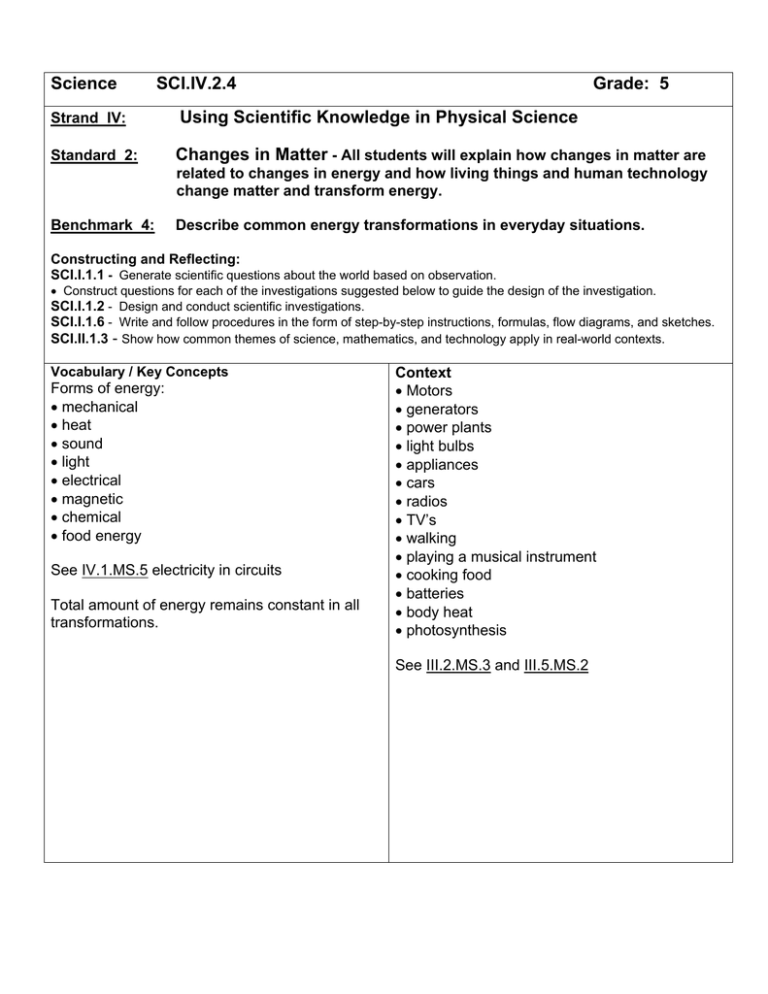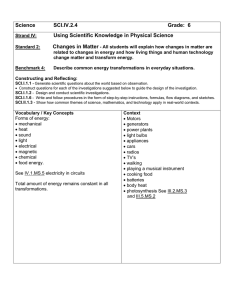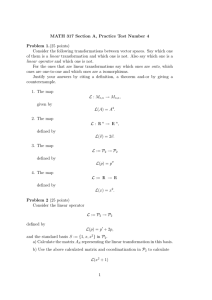Science SCI.IV.2.4
advertisement

Science SCI.IV.2.4 Grade: 5 Strand IV: Using Scientific Knowledge in Physical Science Standard 2: Changes in Matter - All students will explain how changes in matter are related to changes in energy and how living things and human technology change matter and transform energy. Benchmark 4: Describe common energy transformations in everyday situations. Constructing and Reflecting: SCI.I.1.1 - Generate scientific questions about the world based on observation. • Construct questions for each of the investigations suggested below to guide the design of the investigation. SCI.I.1.2 - Design and conduct scientific investigations. SCI.I.1.6 - Write and follow procedures in the form of step-by-step instructions, formulas, flow diagrams, and sketches. SCI.II.1.3 - Show how common themes of science, mathematics, and technology apply in real-world contexts. Vocabulary / Key Concepts Forms of energy: • mechanical • heat • sound • light • electrical • magnetic • chemical • food energy See IV.1.MS.5 electricity in circuits Total amount of energy remains constant in all transformations. Context • Motors • generators • power plants • light bulbs • appliances • cars • radios • TV’s • walking • playing a musical instrument • cooking food • batteries • body heat • photosynthesis See III.2.MS.3 and III.5.MS.2 Knowledge and Skills Students will recognize that energy is never lost, destroyed, or created; it only changes form. In each transformation, students should be introduced to the idea that the amount of energy that goes into a system is the same as the amount of energy that comes out of the system. - When a system is analyzed, scientists must account for all types of energy. In most systems, energy is given off as heat. Appliances, the body, plants, vehicles, musical instruments, toys, cold packs, hand warmers, etc. are examples of systems. In each system, energy changes form. For example, a battery demonstrates chemical energy being transformed to electrical energy. Students will describe the energy transformations in everyday systems. Resources Coloma Resources: The Way Things Work – David Macualay, Hougton-Mifflin 1988 Other Resources: • Teaching Science with Toys: Physics Activities for Grades K-9, Taylor, Poth and Portman • Science Explosion • • Michigan Teacher Network Resources Energy Quest Videoconferences Available For more information, see www.remc11.k12.mi.us/dl or call Janine Lim 4717725x101 or email jlim@remc11.k12.mi.us IV.2.MS.4 Science of Sound from the Cleveland Institute of Music (transformation of energy) Photosynthesis from the Camden Children's Garden Energy from COSI Toledo Sounds of Science from COSI Toledo Molecules and Energy from the New York Hall of Science Instruction Benchmark Question: How are common energy transformations used in everyday situations? Assessment Optional Assessment: After students have investigated various energy transformations the following assessments can be used: Instruction I Focus Question: What kinds of energy transfers occur? Before beginning the explorations students should be familiar with energy and its forms (see key concepts). Also the teacher should perform/discuss everyday examples of energy transformations (burning coal to produce electricity, digestion of food, speakers, photosynthesis, etc.). Assessment I Students create a picture of an environment (a kitchen works well) labeling the energy transfers shown in the picture. Assessment II Pairs of students will observe the energy transformation that occurs when 250 ml (one-half cup) of cold water is combined with fifteen grams Discuss how the energy in a marshmallow comes (one teaspoon) of calcium chloride in a locking sandwich bag. Each student will write a from the energy of the sun to the sugar plant. description of the energy transformation that is occurring and a description of a real-world Students will design ways to make s’mores. application. • Microwave (electric to microwave) • • • • • Light bulb (electric to heat and light) Friction caused by rubbing (mechanical to heat) Body heat (chemical to heat) Candle (chemical to light and heat) Solar (solar to heat) The s’mores also provide food energy/chemical energy which changes to mechanical, heat and sound energy. Instruction II Focus Question: What kinds of energy transfers occur in various toys? The teacher will give each small group a toy that undergoes one or more energy transfers (See Toy Examples below). Groups will investigate the mechanics of their toy and identify its energy transfers. Groups will demonstrate and explain how the types of energy change in their toy. Toy Examples: tops, music boxes, Jack-in-theBoxes, wind-up toys, push and pull toys, string-pull toys, and battery-operated toys. (Give students rubric before activity.) Scoring Rubric Criteria: Accuracy of description — energy transformation: Apprentice - Describes an observation that does not include an energy transformation. Basic -Describes the energy transformation with no details. Meets - Describes the energy transformation with some details. Exceeds - Describes the energy transformation with many details. Criteria: Accuracy of Description-real-world application: Apprentice -Does not describe a real-world application. Basic -Describes a real-world application with no details. Meets - Describes a real-world application with some details. Exceeds - Describes a real-world application with many details. Teacher Notes: The battery or other source provides energy to the electrical current, which is transformed in the circuit devices to other forms of energy (light, heat, sound, motion, etc.) Energy is neither created nor destroyed in this process; it only transforms from one form to another. Focus Questions • What is energy and how does it transfer from one substance to another in everyday situations?







